226 Diversity Plant, Animal, Bacteria (copy)
1/115
There's no tags or description
Looks like no tags are added yet.
Name | Mastery | Learn | Test | Matching | Spaced |
|---|
No study sessions yet.
116 Terms
Archaeplastida
Major group of eukaryotes includes all plants and several types of algae. These organisms gained the ability of photosynthesis through endosymbiosis of cyanobacteria.
Red algae
Green algae and all land plants
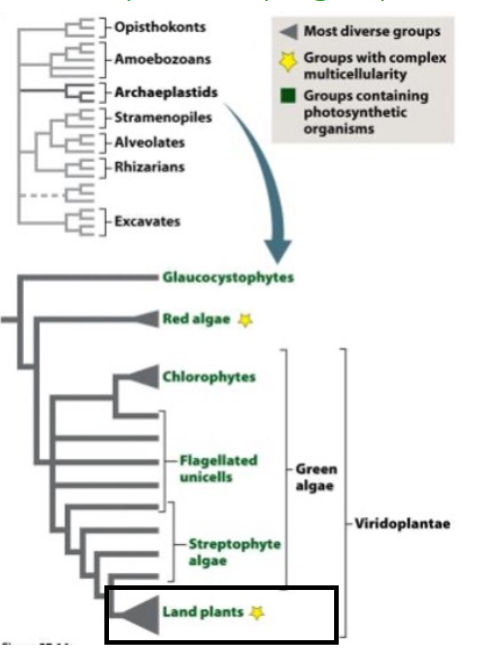
Chlorophytes and Charophytes
Two main groups of green algae
includes chlamydomonas which are unicellular
Charophytes are freshwater algae
Haplontic vs diplontic
Haplontic means the haploid stage is the dominant stage, where as in diplontic the diploid stage is the dominant stage
Haplodiplontic
haploid and diploid stages alternate during life cycle
haploid form is known as a gametophyte
diploid phase is called the sporophyte
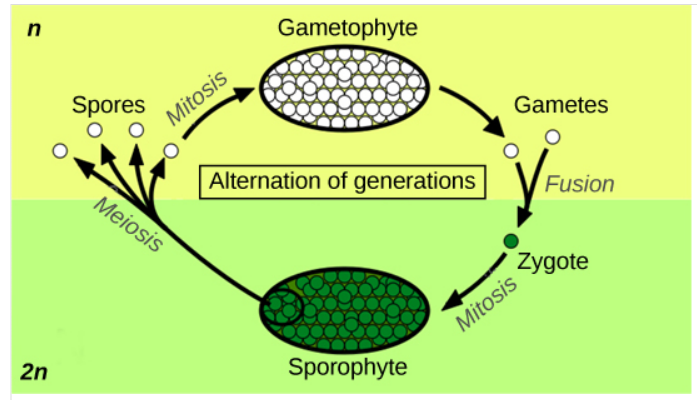
Traits that are specfic for land plants vs lands plants and green algae
Land plants only
stomata
vascular system
cell walls with lignin
Both
Chloroplasts
Relate gametophyte and its dependence on its sporophyte for nonvascular plants, seedless vascular plants and seed-bearing vascular plants.
Nonvascular plants
the gametophyte is independent and larger than the sporohyte
Seedless vascular plants
the gametophyte is smaller than the sporophyte and can live independelty of the sporophyte
Seed-bearing vascular plants
the gametophyte is smaller than and dependent on the larger sporophyte
Bryophytes
Closest extant relatives of early terrestrial plants. Did not form fossils because of a lack of lignin
Includes,
Liverworts
Hornworts
mosses
reliant on diffusion, limited to short height, dependent on water for reproduction
Lack vascular tissue, true roots and leaves, lignin
Have dependent embryos and apical meristems
Classify characteristics of ferns and mosses or both
Both
seedless require water for reproduction
Ferns
have vascular tissues
sporophyte is the dominant life cycle stage
Mosses
lack vascular tissue
gametophyte is dominant life cycle stage
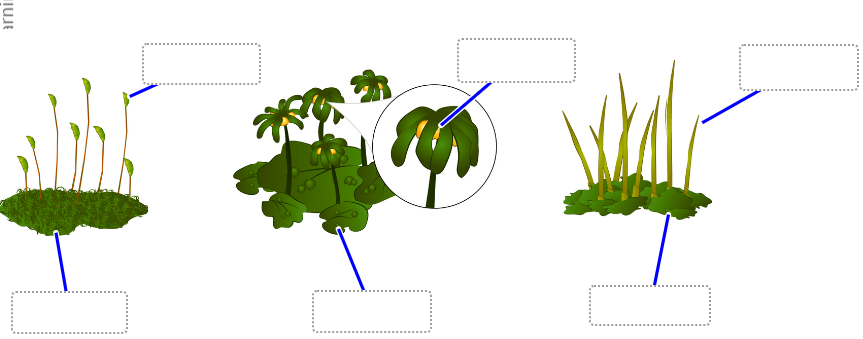
Label the what is the sporophyte vs the gametophyte of the 3 main Bryophytes
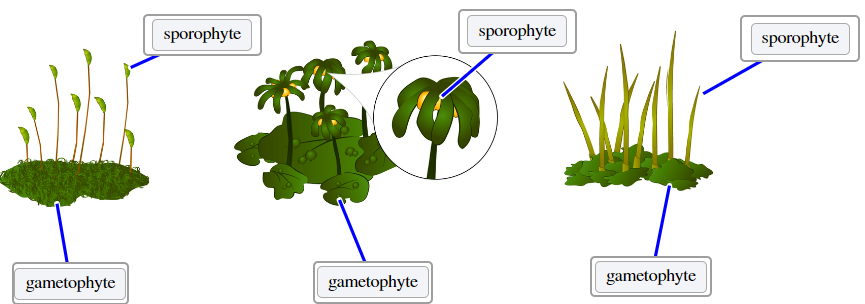
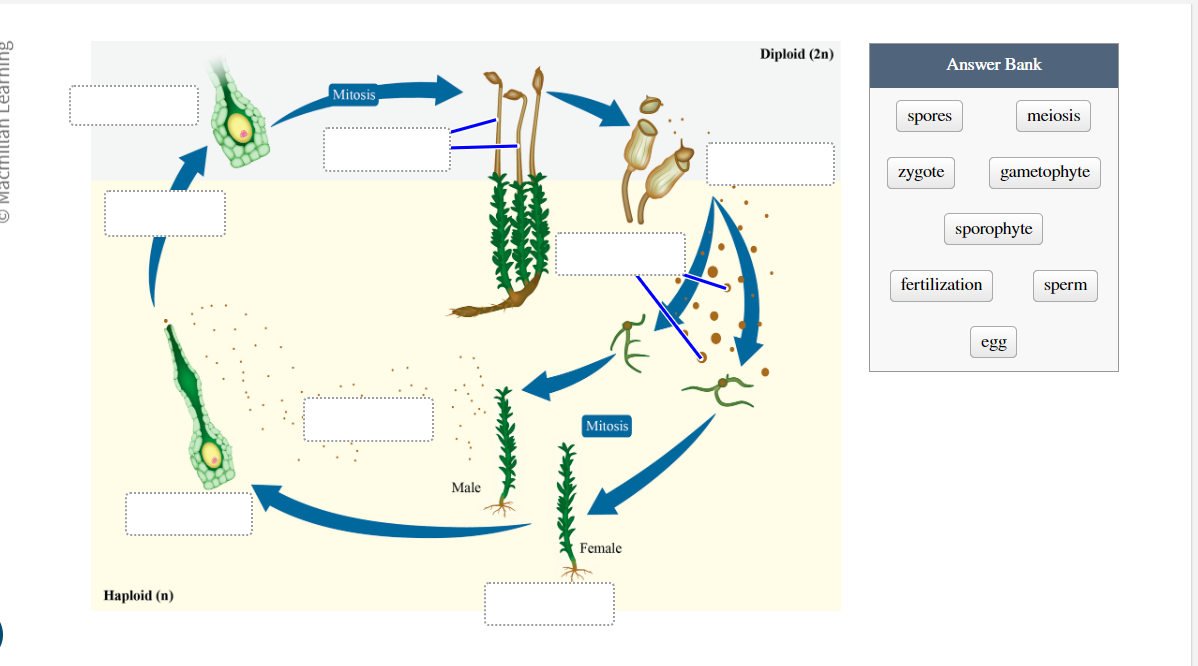
Fill in the blank of a moss life cycle
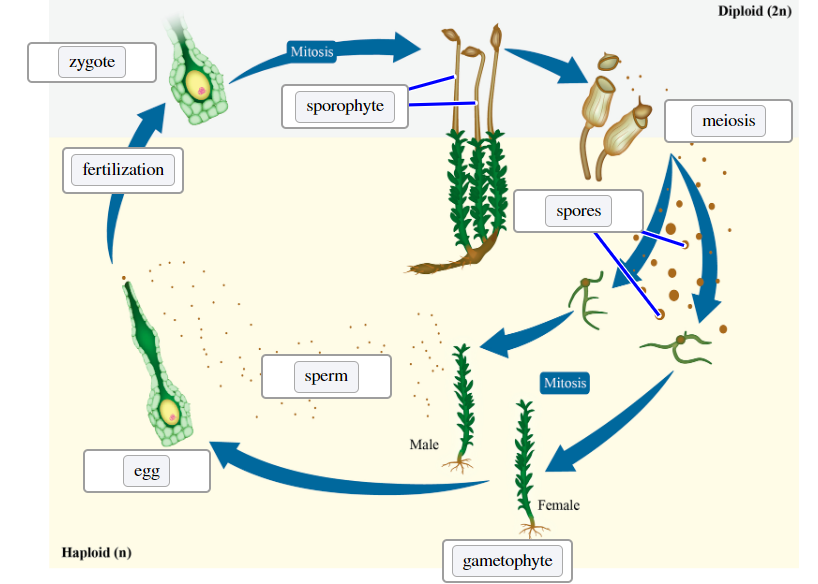
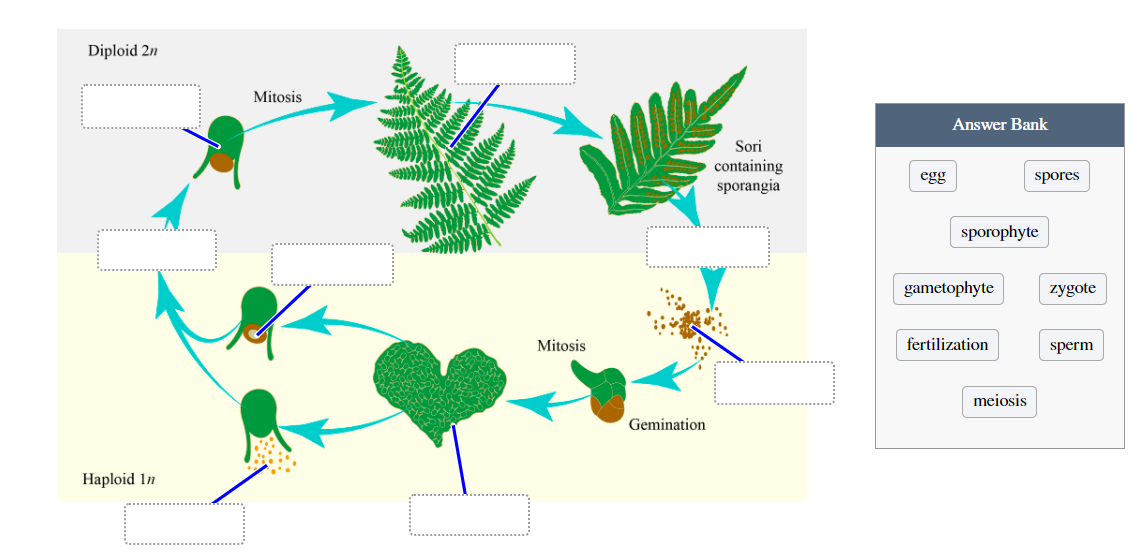
Fill in the blank for the fern life style
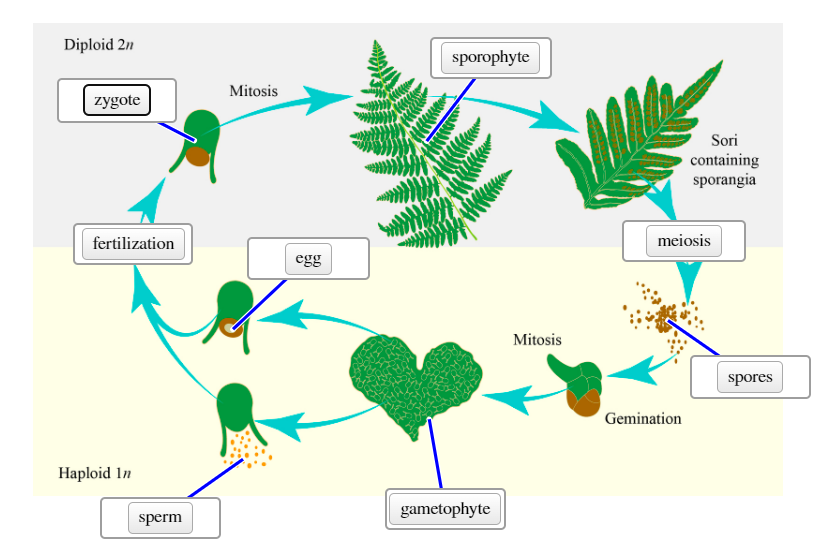
Earliest plants to evolve from earilest to latest
Green algae
nonvascular plants
seedless vacular plants
gymnosperms
angiosperms
What makes the insects successful in different environments?
Flight
travel to food in new environments
Waterproof cuticle
Prevents water loss
Respiration/tracheal system
Prevents water loss
Desiccation resistant eggs
Reproduction in dry environments
Life cycle
Short generations, many offsprings
Complete metamorphosis
Deuterostomes: major Lineages and what makes them different than protostomes
There are three major lineages
1)Hemichordates:
2)Echinodermata
3)Chordata
Indeterminate cleavage
Phylum Echinodermata
Ex. Sea stars, sea cucumbers, sea urchins, brittle stars
All marine, larvea are bilateral and then adult are more radial due to sessile lifestyle, slow moving, ednoskeleton of calcareous plates
Water vascular system
network of hydraulic canals branching into extensions called tube feet, under muscluar control
locomotion, feeding, and gas exchange
The phylum Chordata includes?
Cephalopchordates, tunicates, vertebrates
The phylum chordata has what 4 distinguishing features?
Dorsal hollow nerve cord
flexible, supportive, notochord
pharyngeal slits
filter feeding and later on used for respiration
muscular post-anal tail
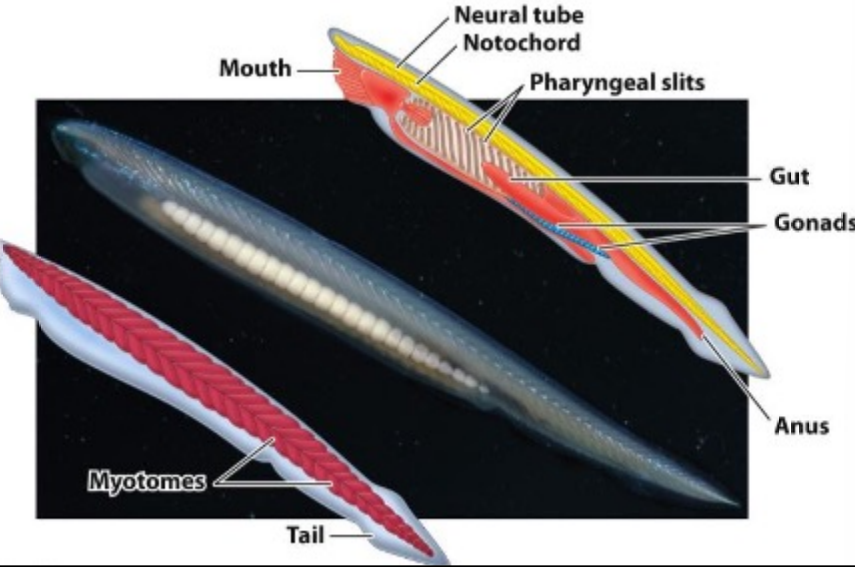
Phylum Chordata, Cephalochordates
Marine organisms that live in the sediment on the bottom of the ocean, and pock their head out of the sand, becuase they are suspension feeders(also known as filter feeders) this is what their pharyngeal slits are for.
Phylum Chordata, Tunicates
Includes salps and sea squirts. They can be sessile, salps, or free-floating like the sea squirts. They are both suspension feeders, and pharyngeal slits are still used for feeding. The larvae have all 4 hallmarks of Chordata
Phylum Chordata, Vertebrates
Vertebrates have craniums and vertebrae, some has bone and cartilage. During embryotic development, vertebrates have all 4 characteristics, but lose them as we grow
Vertebrate phylum tree

Charateristics of the vertebrates: Hagfish and Lamprey
Jawless fishes
Hagfish
partial cranium, lack vertebrae
marine scavengers
Lamprey
parasitic, latching on to other vertebrates and eat flesh of other fish
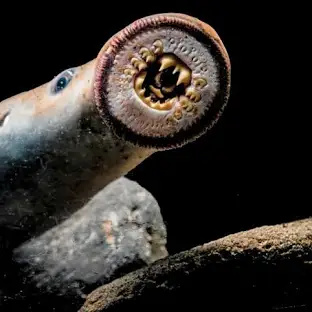
Why was the development of Jaws so beneficial for the vertebrates?
The development of jaws in vertebrates allowed for more efficient feeding mechanisms, enabling a wider range of dietary options and enhancing survival. This evolutionary adaptation also provided greater mobility and predatory capabilities, contributing to the success and diversification of vertebrate species.
eat more things and bigger things
Where did the jaws come from in evolution?
The skeletal rods that supported the phaygneal slits developed into the jaws.
Jawed Vertebrates
Gnathostomes
term that means having jaws
Jaws
teeth
Gills into mandiles
paired fins
help stablity from rolling, and generate lift
Chondrichthymes
Sharks, rays, skates
A cartilaginous skeleton is secondarily derived- ancestors had bones
Swift, not maneuverable
fins are for stabilization and lift
oily livers give buoyancy
Breathe by having mouth open and swimming
Ray-finned fish
bony fishes with bony skeletons
swim bladder (buoyancy)
Operculum
covers gills (pharyngeal slit)
helps breathe without having to move in water
be able to stop and eat, unlike a shark
very diverse
able to evolve to be in different ecological niches
ex. seahorses, pufferfish
Lobe Finned or Fleshy Finned fish
The difference is the structure of their fins
Coelacanths
Marine
Lungfish
freshwater
What are the characteristics of Animals?
Multicellular heteroptrophs
Ingest nutrients; digest internally
Lack cell walls
Embryos with gastrula stages
Collagen
What phylum are animals most closely related too?
Choanoflagellates
Phylum Porifera
Includes sponges, that are all aquatic, sessile suspension feeders, they lack symmetry, they have no tissues, no gut and only get nutrients from diffusion
Animal phylum: Eumetazoa
Includes the Cnidarians and bilaterals. They have tissues and two types of symmetry, radial (jelly fishes) and bilateral (humans crabs)
How does the type of symmetry relate to how an animal moves through its environment?
Animals with bilateral symmetry, such as most vertebrates, typically move in a directed, forward manner because their body is structured with a distinct head and tail, allowing for streamlined, efficient movement, while animals with radial symmetry, like starfish, move in multiple directions or around a central point, often using slow, coordinated motions.
Animal phylum Cnidaria
Invertebrate animal that include all aquatic jellies, sea anemones, corals, and hydra.
radial symmetry
have tissues
diploblastic
ectoderm and endoderm
no mesoderm
mesoglea
diffusion
They have two body forms the polyp and the medusa
Differences between a polyp and a medusa?
A polyp is a nonmotile, sessile form with a tubulat body that is attached to a hard surface, mouth points upwards and can be singular or colonial.
Medusa is a free-floating, bell-shaped form thats comonly called a jellyfish, tentacles and mouth point downwards.
Characteristics of the Bilateral animals phylums
bilateral symmetry
triploblastic
ectoderm
mesoderm (complex organs)
endoderm
Body cavity (coelom)
acoelomate
pseudocoelomate
coelomate
have a mouth and anus
Explain the differences of Acoelomate, Pseudocelomate, and Coelomates.
Acoelomates lack a body cavity between the digestive tract and the outer body wall, with the space filled by solid tissue, as seen in flatworms.
Pseudocoelomates have a body cavity (pseudocoel) that is not fully lined by mesoderm, as seen in roundworms.
Coelomates possess a true coelom, a body cavity completely lined by mesoderm, providing space for organs to grow and move independently, as found in most animals, including humans.
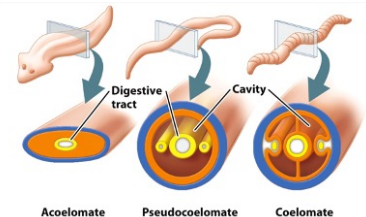
What are the two major lineages of the bilateral animalia phlyums?
Deuterostomes
anus is developed first from blastopore
indeterminate cleavage(seperated cells can develop into a full organism) This is how identical twins are made.
Protostomes
mouth develops first from blastopore
determiate cleavage (cells are predetermined, seperate cells cannot grow into a full organism)
What are the two major lineages of Protostomes?
Lophotrochozoans
annelid worms
mollusks
Ecdysozoans
Phylum Annelida
Segmented worms (controlled movement) w/ a closed circulatory system
includes earthworms, leeches, polychaete worms
both terrestrial and aquatic
Phylum Mollusca
Gastropods, bivalves, and cephalopods
aquatic and terrestrial
ex. squids, snails, clams
Animilia Ecdysozoa’s
Includes, arthopods, nematodes, tarigrades
characteristics include
cuticle
ecdysis(shedding and molting
exoskeleton
Phylum Arthropoda
Characteristics
chitinous exoskeleton
jointed appndages
segmentation
tagmatization
inlcudes the
Chelicerates (spiders)
myriapods
crustaceans
Insects
Chelicerates
Includes spiders, scorpions, horseshoe crabs
cephalothorax and an abdomen
anterior-most appendages are modified chelicerae
8 legs
Myriopods
Includes milipedes (herbivores) and centipedes (carnivores)
Crustaceans
Insects of the Sea
nearly all marine
decapods, isopods, copepods, branchioposd and barnacles
Insects
Most successful group of animals, they make up 70% of all animal species.
Body plan includes, thorax, abdomen and three sets of legs and usually wings
How did the two prokaryotic domains seperate?
In 1977, George Fox and Carl Woese compared the rRNA genes and recongized two distinct prokaryotic groups.
When did bacteria life began?
3.5 bya
Are gram negative bacteria more or less susceptible to antibiotics?
They are less sesceptible to antibiotics becuase they have more pepitogylcan protection.
How do prokaryotes reproduce?
asexually by binary fission
Conjunction
Bacterita to bacteria horizontal gene transfer through a pilus
Transformation
DNA transfer bacteria to bacteria through picking up a plasmid in the enviroment
Transduction
DNA transfer by a virus to a bacteria, gets injected
Different types of nutrition absorbtion
Phototroph- light
Chemotroph- chemical inorganic or irganic
heterotroph- organic sources (glucose)
autotroph- inorganic sources (CO2)
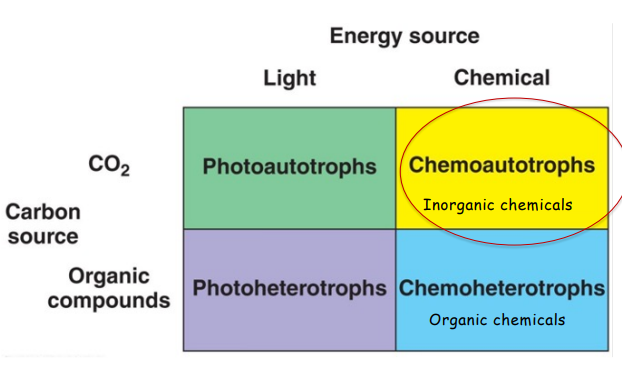
What source of nutrites is unique to prokaryotes?
Chemoautotrophs
Ascomycota (ascomycetes)
Commonly known as sac fungi
Chitin
Chitin is a long-chain polymer of N-acetylglucosamine, a derivative of glucose, and serves as a structural component in the exoskeletons of arthropods, the cell walls of fungi, and the shells of some mollusks. It provides strength and protection, similar to how cellulose functions in plant cell walls.
Hypha (hyphae)
A hypha is a long, branching filamentous structure that makes up the body of a fungus. Hyphae grow and spread to form a network called a mycelium, which is responsible for nutrient absorption and reproduction in fungi.
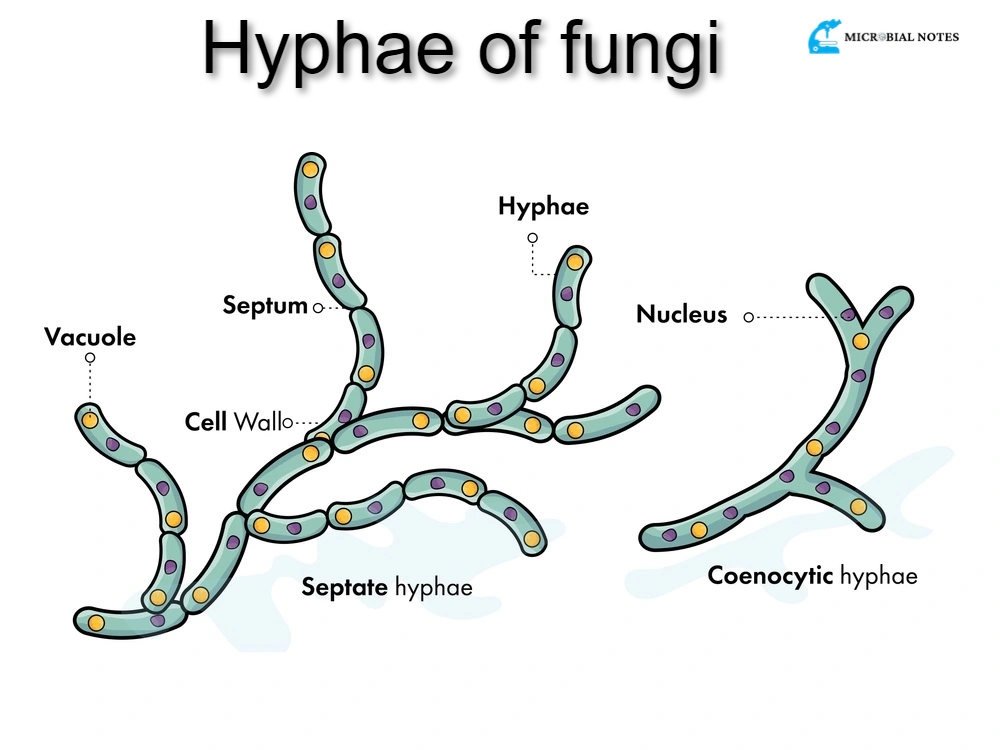
Mycelium
The whole mass of fungi hypha, the white fuzzy part
Yeast
a single-celled fungus that reproduces by budding
Septa
Septa, or cross walls, are internal walls that divide the hyphae of most fungi into cells
Fruiting bodies
The fruiting bodies of fungi contain spores, which are dispersed for reproduction
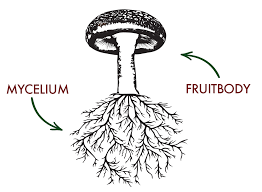
Plasmogamy
Plasmogamy is a stage in the sexual reproduction of fungi, in which the protoplasm of two parent cells (usually from the mycelia) fuse without the fusion of nuclei, effectively bringing two haploid nuclei close together in the same cell.
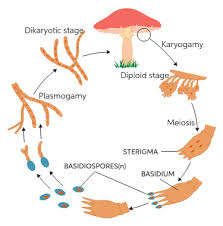
Heterokaryotic vs Dikaryotic Fungi
Heterokaryotic fungi have cells with two or more genetically distinct nuclei within the same cytoplasm, which can result from the fusion of different fungal strains.
Dikaryotic fungi specifically have two distinct haploid nuclei per cell, one from each parent, which coexist without immediately fusing, typical in the sexual reproduction phase of many fungi like basidiomycetes.
List in Order the vertebrate evolution
Cranium
Hagfish
Lampreys
Jaws
sharks and rays
ray-finned fish
Gas Bladder and Lung Derivative
coelacanths
Lungfish
walking legs
frogs
salamanders
caecilians
Amniotic egg
snakes and lizards
turtles
crocodiles/alligators
birds
Mammary glands and hair
mammals
-
Describe the ecological relationships between fungi and other organisms.
Fungi can have different relationships with other organisms: they can help plants by providing nutrients in exchange for sugars (mutualism), harm plants or animals by feeding on them (parasitism), or break down dead matter to recycle nutrients into the environment (decomposition). These interactions are important for ecosystems.
Recognize the major groups of Fungi
Ascomycota (ascomycetes)
Basidiomycota (basidiomycetes)
Chytridiomycota (chytrids)
Glomeromycota (glomeromycetes)
Zygomycota (zygomycetes)
Ascomycota (Ascomycetes)
Characteristics: These fungi produce spores in sac-like structures called asci. They can be unicellular (like yeasts) or multicellular.
Examples: Yeasts (e.g., Saccharomyces cerevisiae), molds (e.g., Neurospora), and the pathogen Aspergillus.
Basidiomycota (basidiomycetes)
Characteristics: These fungi form spores on club-like structures called basidia, typically found on fruiting bodies such as mushrooms.
Examples: Mushrooms (e.g., Agaricus), puffballs, and shelf fungi.
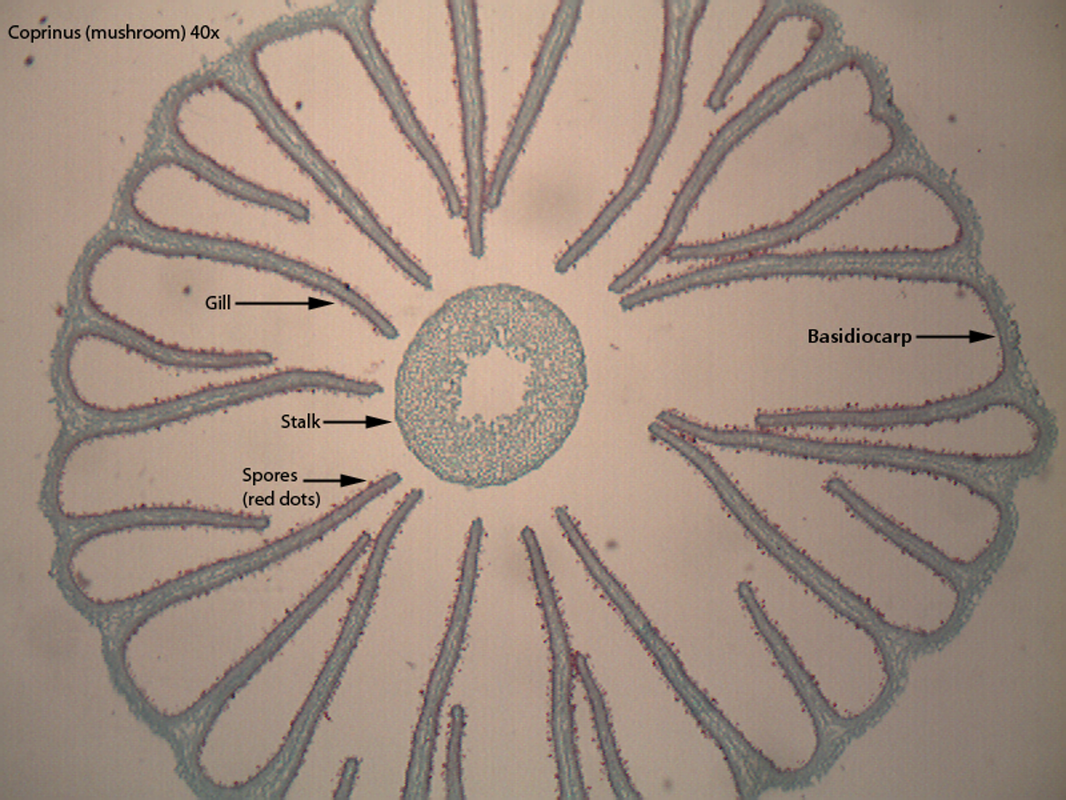
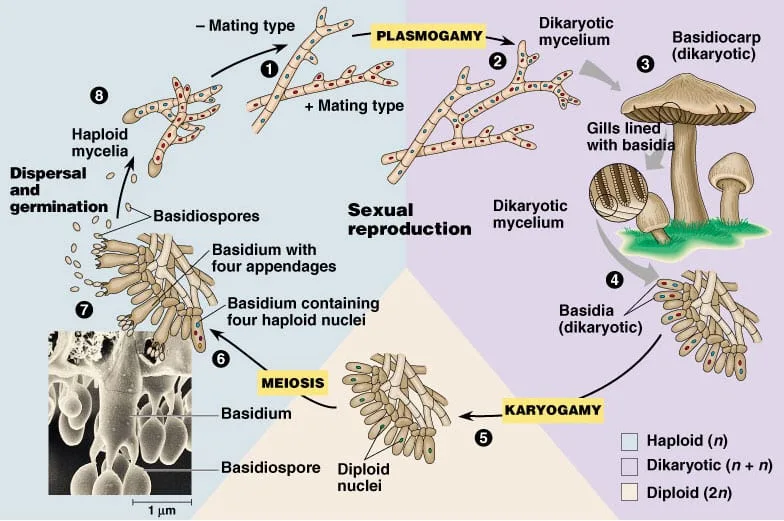
Which life cycle is this?
Basidiomycota

What life cycle is this?
Ascomycota

Chytridiomycota (chytrids)
Characteristics: These are mostly aquatic fungi with simple, motile spores (zoospores) that have flagella. They are often associated with amphibian diseases.
Examples: Batrachochytrium dendrobatidis (a pathogen affecting amphibians).

What lifecycle is this?
Chytridomycota
Zoospore
A zoospore is a reproductive cell that moves around using a flagellum to swim to a favorable environment for development
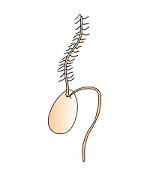
Sporangium
A sporangium is a structure in which spores are produced and contained, commonly found in fungi, plants, and some algae. In fungi, the sporangium is where asexual spores (like conidia or sporangia) are formed, while in plants, it is the structure that produces and releases spores during the reproductive cycle (e.g., in ferns or mosses).
meiosis to produce spores
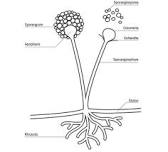
Glomeromycota (Glomeromycetes)
Characteristics: These fungi form symbiotic relationships with plant roots, creating mycorrhizae, which help plants absorb nutrients, especially phosphorus.
Examples: Arbuscular mycorrhizal fungi (e.g., Rhizophagus species).
Zygomycota (Zygomycetes)
Characteristics: These fungi typically have asexual spore-producing structures called sporangia and sexual reproduction involving the formation of zygosporangia.
Examples: Rhizopus (black bread mold) and Mucor species

What life cycle is this?
Zygomycota
Sporangia
produces and stores spores, found on plants fungi and other groups
Describe the various adaptations plants have for terrestrial life.
Waxy Cuticle: Prevents water loss.
Stomata: Regulate gas exchange and water loss.
Vascular Tissue: Transports water, nutrients, and sugars.
Roots: Anchor the plant and absorb water/nutrients.
Reproductive Adaptations: Seeds and pollen allow reproduction without water.
Lignin: Provides structural support for upright growth.
Leaf Adaptations: Vary to optimize water use or sunlight capture
Xylem
Xylem is a type of vascular tissue responsible for transporting water and dissolved minerals from the roots to the rest of the plant. It also provides structural support, as the walls of xylem cells are strengthened with lignin.
Lignin
Lignin is a tough substance in plant cell walls that helps plants stay upright and resist damage. It also helps plants transport water efficiently.
Xylem vs Phloem
xylem is used for water and nutreint transport, phloem is used for sugar distribution
Explain the alternation of generations of life cycle of plants.
Alternation of generations in plants is a life cycle where plants switch between two stages: a haploid (single set of chromosomes) stage and a diploid (two sets of chromosomes) stage.
The haploid stage is called the gametophyte, which produces reproductive cells called gametes (like sperm and eggs).
When gametes from two plants fuse during fertilization, they form a diploid zygote, which grows into the sporophyte.
The sporophyte produces spores through a process called meiosis, which are haploid cells. These spores grow into new gametophytes, completing the cycle.
So, plants alternate between these two generations: the haploid gametophyte and the diploid sporophyte.
For the mosses, which generation is dominant?
Dominant gametophyte and dependent sporophyte
flagellated sperm
Which phylums are the vascular plants?
Seedless plants
lycophytes
ferns and horsetails(Pterophytes)
Seed plants
gymnosperms
angiosperms
Seedless Vascular Plants
Lycophytes(club moss) there used to be tree sized lycophtes 32o mya and Pterophytes(ferns and horsetails)
well-developed roots and leaves
vascular tissues
lignin
no secondary growth
Ferns and horsetails
underground stems
pinnae
radiated after rise of angiosperms
lack secondary growth but reach large size
What is the difference between primary growth and secondary growth in plants?
Primary growth in plants refers to the increase in length or height, occurring at the tips of roots and shoots (apical meristems). This type of growth allows plants to extend their roots deeper into the soil and their stems toward the light.
Secondary growth involves the thickening of the plant's stems and roots, occurring in woody plants through the activity of lateral meristems (like the cambium). This growth adds girth to the plant and allows it to grow thicker, which is important for supporting larger structures and transporting more water and nutrients.
Why was there an evolutionary trend that increased the importance of the sporophyte stage (2n) of the plant life cycle?
The sporophyte stage became more important because it allows for greater genetic diversity, larger size, and better protection of offspring, helping plants adapt to land environments. It also reduces reliance on water for reproduction, supporting plant survival in diverse habitats.